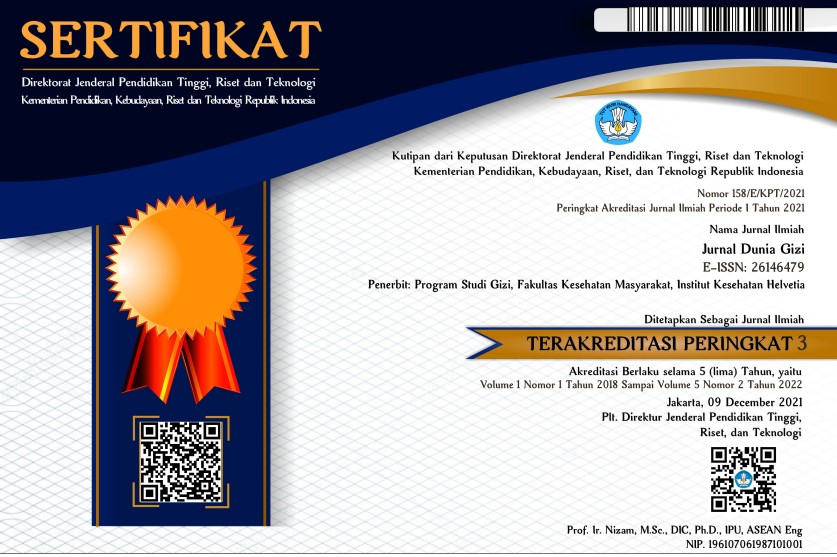The Potential of Low Glycemic Index Meals as a Factor to Enhance Endurance and to Prevent of Injury in Athlete
Abstract
Background; Endurance is the ability of athlete can do some works to be efficiency and effective in long time where the athlete can feel without more exhausted. Objectives; this review is to describe the studies that showed evidence of LGI to improve endurance performance athlete where can neglect accident of injury. Method; this review used comparative review journal to emphasise for benefit in food of low index glycemic in athletes. Results; Some studies reveal the idea to highlight evidence that LGI meal will give more effect to reduce lactate acid in blood glucose where endurance athlete is more stable than HGI meal. Conclusion; This review also provide the information of benefic LGI meal for health athlete and propose program mechanism LGI meal for people.
Keywords
Full Text:
PDFReferences
Sukarmin Y, Jurusan D, Kesehatan P, Fik R. Cedera Olahraga Dalam Perspektif Teori Model Ekologi. Medikora. 2005;1:11–22.
Parwata IMY. Kelelahan dan Recovery dalam Olahraga. J Pendidik Kesehat Rekreasi. 2015;1:2–13.
Laursen paul B. Models to Explain Fatigue during Prolonged Endurance Cycling. Sport Med. 2005;35(10):865–98.
Purwanti. Suplemen, Tak Bantu Atasi Kelelahan. 2008; Available from: http://www/mediaindonesia.com/
Brevi Istu Pambudi. Pengaruh Pemberian Makanan Indeks Glikemik Tinggi dan Rendah Terhadap Kelelahan Otot Atlet Badminton. Universitas Gadjah Mada Yogyakarta; 2013.
Oborne DJ. Ergonomic at Work: Human Factors in Design an Development. Thirth. England: West Sussex; 1995.
Suma’mur PK. Higiene Perusahaan dan Kesehatan Kerja. Jakarta; 1990.
Tecky Indriana. Pengaruh Kelelahan Otot Terhadap Ketelitian Kerja. Stomatognatic. 2010;7(3):49–52.
Giriwijoyo. Ilmu faal Olahraga. Fungsi Tubuh Manusia pada Olahraga untuk Kesehatan dan Prestasi. Bandung: FPOK UPI; 2010.
Bompa TO. Periodization Theory and Methodology of Training. Fifth Edition. United State of America: Human Kinetic; 2009.
Hartono. Coaching dan Aspek-aspek Psikologis dalam Coaching. Jakarta: Departemen P dan K; 1988.
Kusnanik N. W. Dasar-dasar Fisiologi Olahraga. Surabaya: Unesa University Press; 2011.
Sayono. Biokimia Otot. Yogyakarta: Nuha Medika; 2011.
Soekarman. Dasar Olahraga. Jakarta: Inti Idayu Press; 1987.
Congeni JA. Dealing with Sport Injuries. Kids Heal [Internet]. 2004; Available from: http://kidshealth.org/teen/food_fitness/sports/sport_injuries.html.
Dunkin MA. Sport Injuries. NIAMS [Internet]. 2004; Available from: http://www.niams.nih.gov/hi/topics/sport_injuries/SportsInjuries.html
Rusli Lutan. Penanggulangan Cedera Olahraga pada Anak Sekolah Dasar. Jakarta: Ditjen Olahraga; 2001.
Giam, C.K. dan Teh KC. Ilmu Kedokteran Olahraga (Hartono Satmoko Terjemahan). Jakarta: Binarupa Aksara; 1993.
Afifi SN. Kondisi fisik atlet bulutangkis klub djarum kudus dan faktor yang mempengaruhi (. Universitas Negeri Semarang; 2015.
Debbian A RC. PROFIL TINGKAT VOLUME OKSIGEN MASKIMAL. J Olahraga Prestasi. 2016;12:19–30.
Hosseini S, Valizadeh R. The effect of resistance training on some pulmonary indexes , body composition , body fat distribution and VO2max in thin and fat men of personal and members of faculty of Azad university Bebahan branch. 2012;46(2):3051–5. Available from: http://dx.doi.org/10.1016/j.sbspro.2012.06.008
Widiyanto. Latihan Fisik dan Laktat. J Midikora. 2007;
Wiarto. Fisiologi dan Olahraga. Yogyakarta: Graha Ilmu; 2013.
Dewi EK KM. Hubungan Asupan Zat Gizi Makro dan Status Gizi Terhadap Kebugaran Atlet Bulutangkis Jaya Raya Pada Atlet Laki-Laki Dan Perempuan di Asrama Atlet Ragunan Tahun 2013. EJurnal Nutr Diaita [Internet]. 2013;5. Available from: http://hellis.litbang.kemkes.go.id:8080/jspui/handle/123456789/21623
Sahara, Mailina Prima., Nurmasari Widyastuti AC. Kualitas Diet dan Daya tahan (Endurance) Atlet Bulutangkis Remaja di Kota Semarang. ejournal3 undip [Internet]. 2019;8:29–37. Available from: http://ejpurnal3.undip.ac.id/index.php/jnc/
Díaz EO, Galgani JE, Aguirre CA. Glycaemic index effects on fuel partitioning in humans. 2006;219–26.
Reilly JO, Wong SHS, Chen Y. Glycaemic Index , Glycaemic Load and Exercise Performance. 2010;40(1):27–39.
Lopes M V, Alfenas RDCG. Effect of the glycemic index on lipid oxidation and body composition. 2011;
Jenkins L, Bowling C, Newman C, Goff V, Biol M, et al. glycemic index of foods: a physiological basis for carbohydrate exchange. 2018;(January):362–6.
FAO/WHO. Carbohydrate in Human Nutrition. 1998;66:1–140. Available from: http://www.fao.org/3/x2650T/x2650t02.htm
Aston LM. Glycaemic index and metabolic disease risk. 2006;125–34.
Hargreaves M, Hawley JA, Jeukendrup A. Pre-exercise carbohydrate and fat ingestion : effects on metabolism and performance Pre-exercise carbohydrate and fat ingestion : effects on metabolism and performance. (June 2012):37–41.
Wolever T JD. The use of the glycemic blood glucose response. J Sci Med Sport. 1986;43(January):167–72.
Henry CJK, Lightowler HJ, Strik CM, Renton H, Hails S. Glycaemic index and glycaemic load values of commercially available products in the UK. 2005;44:922–30.
Moore LJS, Midgley AW, Thurlow S, Thomas G, Mc LR. Effect of the glycaemic index of a pre-exercise meal on metabolism and cycling time trial performance. 2010;13:182–8.
Jamurtas AZ, Deli CK, Georgakouli K, Fatouros IG. Chapter 2 - Glycemic Index, Food Exchange Values, and Exercise Performance [Internet]. Second Edition. Nutrition and Enhanced Sports Performance. Elsevier Inc.; 2019. 11–29 p. Available from: https://doi.org/10.1016/B978-0-12-813922-6.00002-3
Laparidis K, Volaklis KA, Douda HT, Tokmakidis SP. The Effects of Pre-Exercise Glycemic Index Food on Running Capacity The E ff ects of Pre-Exercise Glycemic Index Food on Running Capacity. 2011;(May).
DOI: https://doi.org/10.33085/jdg.v2i2.4559
Refbacks

This work is licensed under a Creative Commons Attribution-NonCommercial 4.0 International License.









1.png)







.png)










